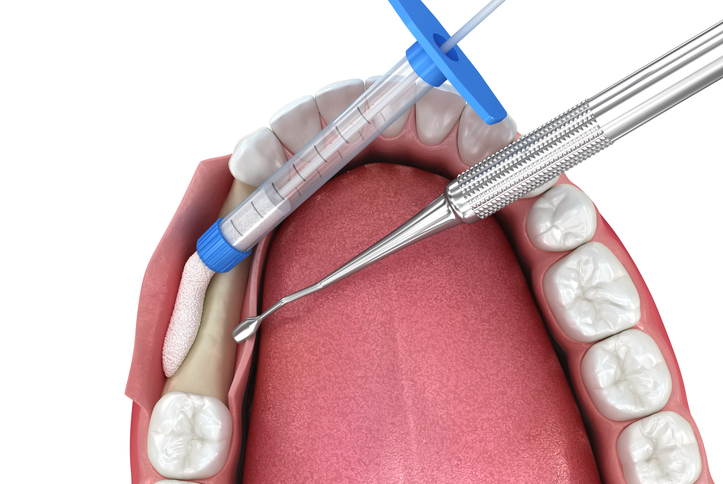
In this blog, we’ll explore the essential role bone grafting plays in the dental implant process, why it’s necessary for some patients, and what you can expect during and after the procedure.
Why Bone Health Matters for Dental Implants
Dental implants rely on a strong and healthy jawbone to provide stability and longevity. The implant is surgically placed into the jawbone, where it fuses with the bone over time through a process called osseointegration. This fusion creates a sturdy foundation that supports the dental crown, bridge, or denture attached to the implant.
When a tooth is lost, the jawbone in the area begins to shrink due to lack of stimulation from chewing. Over time, this bone loss can become significant, making it difficult or impossible to place a dental implant securely. Bone grafting helps rebuild and restore the lost bone, ensuring the jaw is strong enough to support implants and maintain long-term oral health.
When Is Bone Grafting Necessary?
Bone grafting isn’t required for every dental implant patient, but it is common in cases where:
- There Is Significant Bone Loss: Patients who have been missing teeth for an extended period may have experienced severe bone resorption.
- Periodontal Disease Has Damaged the Jawbone: Advanced gum disease can lead to bone loss, creating the need for bone grafting before implant placement.
- Trauma or Injury Has Affected the Jaw: Accidents or injuries that damage the jawbone can compromise its integrity, necessitating grafting.
- The Sinus Cavity Is Too Close to the Upper Jaw: For implants in the upper back jaw, a sinus lift (a specialized form of bone grafting) may be needed to create sufficient bone height.
What Is Bone Grafting?
Bone grafting is a surgical procedure designed to repair and rebuild bone in areas where it has been lost or weakened. During the procedure, a bone graft material is placed in the area of deficiency to encourage new bone growth. Over time, the graft integrates with your existing bone, creating a solid foundation for dental implants.
Types of Bone Grafting Procedures
The type of bone grafting recommended depends on the specific needs of your jaw and dental implant treatment plan. Common types include:
- Socket Preservation: Performed immediately after a tooth extraction to prevent bone loss and preserve the socket for future implant placement.
- Ridge Augmentation: Used to restore the natural contour and width of the jawbone that has been lost due to bone resorption.
- Sinus Lift: Adds bone to the upper jaw near the molars and premolars, lifting the sinus membrane to make room for the graft material.
- Block Bone Grafts: In cases of severe bone loss, a small block of bone from another area of your body or a donor source is used to rebuild the jawbone.
What to Expect During a Bone Grafting Procedure
At Implant & Perio Center of Kansas, our team ensures that every patient is comfortable and well-informed throughout the process. Here’s what you can generally expect:
- Consultation and Planning: During your initial visit, Dr. Sams will perform a thorough examination of your mouth, including digital imaging to assess your bone health. He will also discuss your treatment plan and address any questions you may have.
- The Procedure: The bone grafting process is typically performed under local anesthesia. Depending on the type of graft, the procedure may involve placing bone graft material directly into the jawbone or securing a block graft with small titanium screws. The site is then closed with sutures to promote healing.
- Recovery: Healing from a bone graft procedure can take several weeks to months, depending on the extent of the grafting and your body’s natural healing process. During this time, the graft material integrates with your existing bone to create a strong, stable structure.
Aftercare and Recovery
Proper aftercare is essential to ensure the success of your bone graft. Our team will provide detailed instructions on how to care for the surgical site, including:
- Maintaining good oral hygiene without disturbing the graft site.
- Avoiding certain foods and beverages that could interfere with healing.
- Taking prescribed medications to manage discomfort or prevent infection.
Most patients are able to resume their normal activities within a few days, though complete healing can take several months. Dr. Sams will monitor your progress closely to determine when you’re ready for the next step in your implant journey.
The Benefits of Bone Grafting for Dental Implants
Bone grafting offers numerous advantages, including:
- Improved Implant Success Rates: By restoring bone density, grafting increases the likelihood of successful implant placement.
- Enhanced Facial Aesthetics: Rebuilding the jawbone can restore natural facial contours, improving overall appearance.
- Long-Term Oral Health: Strengthening the jawbone helps prevent further bone loss and supports overall dental health.
Building a Strong Foundation for Your Smile
At Implant & Perio Center of Kansas, we understand that every patient’s needs are unique. That’s why our team is committed to providing personalized care and comprehensive treatment plans tailored to your goals and oral health. Whether you’re considering dental implants or have been told you need bone grafting, we’re here to guide you every step of the way.
Take the first step toward restoring your smile by scheduling a consultation with Dr. Sams today. Together, we can help you achieve a healthier, more confident smile.
